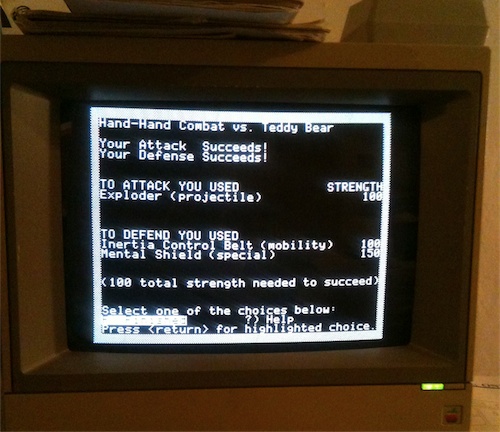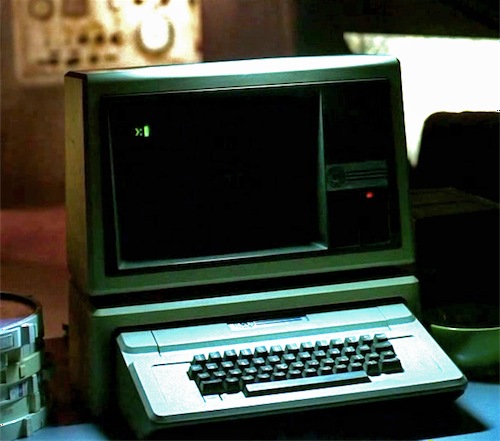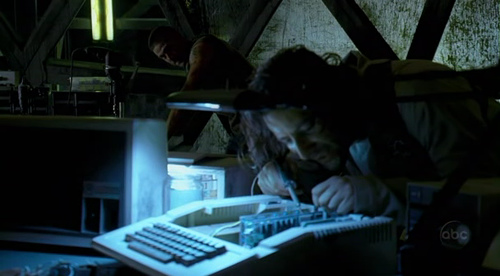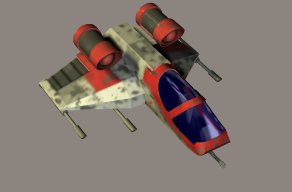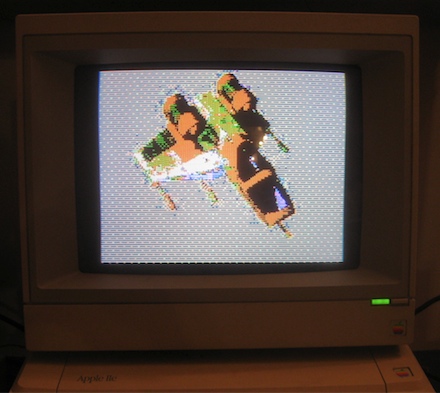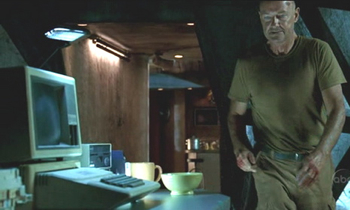Well, trying to play two characters at once was a mistake. The game’s cumbersome enough with switching between the computer Game Master, the game board, and the many booklets – also switching between characters was too much. So I dropped Professor Lee Dambroke, the xenobiologist whose goal was to “bring back undeniable proof of three alien abilities that seem like ‘magic’ to your colleagues.” Sorry, Prof.
Playing just Laran Darkwatch, I fell into a much more enjoyable groove with the game. Darkstar is a heretic “Reverend High Councilor of the Final Church of Man”. His heresy comes from believing, based on years of study, that the central religious text of his order, The Holy Text Files, is incomplete. His secret goal is to find the lost Seventh Holy Text File, somewhere beyond the Boundary (the Final Church also believes travel beyond the Boundary is sacrilege, so Darkwatch is *doubly* a heretic).
Before we start Darkwatch’s journey, I’d like to point out the great black-and-white illustrations by Will McLean that are sprinkled thoughout the instruction manual and portions of the booklets:

Take that!
Also, I think I suggested in my last entry I suggested you type in the codes of your desired actions, but standard actions on a planet are listed in a menu you choose from, like this:

Choices, choices
Notice the “*) To enter an unlisted action” option — that’s where you’d actually type in an otherwise unknown action code. I’ll have more on that game mechanic later.
Darkwatch on the Move
So, the first five turns of the game are plotted out for you in the booklet entries, teaching you how to interact with the Game Master (henceforth the CGM) work. This had me traveling to the planet Medsun, where the natives have emotional telepathy. They don’t understand some forms of human thinking like mathematics, but they have a black magic-like power called Phrmm. I wanted to explore that further, but the first-turns walkthrough had me leave Medsun for Wellmet, where there’s a set-piece of all the players meeting in the same tavern (whether they’re played by humans or not), where a mysterious figure gives them star maps. These star maps expand the game board (you switch to the other, larger map) and show the locations of previously unknown planets (just their locations, they are unnamed). At this point, you are free to travel at will.
My character booklet suggested I check out Cathedral, a world connected to the finding of the Holy Text Files, so I set off there. Looking for clues in a promising-looking ruin, I was attacked by a hungry dog (kind of prosaic for a space adventure, eh?). I was able to scare the dog away with an Exploder weapon I bought at Wellmet, but he managed to seriously maul me first, I had to rest and heal for several turns. I then (doggedly?) went back to the ruins again, figuring the dog had had enough, but no! Once again I was viciously mauled before the Exploder scared the mutt away. The combat results each of these times showed my attack succeeding but my defense failing, so obviously I needed to upgrade my melee defense. There’s a force field for sale on Wellmet for just such a need, but to purchase it I needed some trade goods I didn’t have yet. I’d have to travel around and do more trading in order to get the goods that’d allow me to get the item that’d allow me to slip past the mutt.

Market goods
I travelled to one of the suggestive ‘unknown planet’ dots on the expanded map and discovered the planet Jaquer. It was actually an asteroid belt instead of a planet, inhabited by a race called the Darscians. After spending some turns to learn their language, I found out their history. They were visited by the technologically superior ‘Mentor’ race, who genetically engineered the Darscians to be non-violent, and gave them the tech of space flight. I also learned the names, but alas not the locales, of the other Darscian planets and what goods they sell. It looks like I could get all the goods I need to buy the force field from Darscian worlds, if I can find the goods the Darscians want to trade for. I spent some additional turns studying Darscian tech and gained an item – an Inertia Control Belt – for my troubles, but wasn’t sure what the Belt was for. Additionally, I learned I could buy a ‘cargo drone ship’ that would allow me trade with any Darscian world no matter where my ship was – that could end up being very handy, but I couldn’t afford it yet.
Next I discovered the planet Withel, whose inhabitants have a class divide between those who are poor and those who can afford to have machine parts integrated with their bodies, all cyborg-like, by the planet-bound Constructor machine. There’s also a social stigma for not being able to have your shiny bits maintenanced yearly by the Constructor. Social worship of this planet-bound machine (I guess they haven’t figured out a way to move it?) has keep the Withelians from being a space-faring race. The Constructor was gifted to them by a superior alien race. Could this be the same advanced race that helped out the Darscians? My sci-fi trope sense says yes.
Gameplay Among the Text Passages
Additional time spent on Withel won me plans for a human-usable Universal Translator (I otherwise have to burn some turns learning the language of each new race I encounter). The plans are basically a recipe of what goods/items I would need, and a special action code to enter when I actually want to build it, once I have the needed components. This introduces the gameplay element of hidden info — unlisted actions you have to enter manually.
My time on Withel and Jaquer brings up another gameplay point. I’m usually exploring all options on each planet, but if I were playing multiplayer, I assume there would be a bit of time pressure from wanting to complete your quest before the others — and that this would keep me from dawdling at each planet when I really need to find an advantageous trade market (which I haven’t yet).
Exercise Does a Body Good
Next I discovered Baphi, a world on which some abandoned industrial waste, I mean, helpful leaking chemicals allowed me to scoop up some Fluid trade goods for free. I also discovered another recipe for a special item — a Ship Shield Generator, which would protect my lowly craft the way the Force Field could protect my lowly body. Unfortunately, its list of required components was quite long, so it’ll be a while before I can construct it.
Investigating the wreckage of an old colony, I bumbled into and activated an alien exercise machine that pummeled me a tad but also gave me Superhuman Speed – this is the first Ability I’ve earned in the game, a small bit of RPG-like character development showing up. I wondered if this would help me in combat against the dog, and checking my Status Display with “Show Combat Category Information” on (something I hadn’t done yet), found my newfound Speed Ability *and* my Intertia Control Built listed as giving a Mobility bonus to Hand-to-Hand combat:

You're in for it now, dog.
I was excited to try out my leveled-up self on Cathedral, but there was more thing to investigate on Baphi, a mysterious space helmet in the wreckage. Putting it on gave me a strange but incomplete vision as I initiated consciousness-melding with the planet (!). It was exhausting, but I was told I could try again, in order to see more of the vision, at risk of my mental health. This was the first time I was offered a choice directly by the program only, instead of by booklet and program:

Hm, this seems a Lovecraftian kind of bargain…
I decided to forgo the extra knowledge and keep my fragile sanity, and return to the helmet later if I could.
Yo Ho Ho
On the way back to Cathedral to see if I’d have better luck vs. that jerk dog, I was stopped by Silverbeard the Pirate who politely demanded I give up 3 trade goods or be attacked! Seeing as I hadn’t bought any ship weapons nor built by Ship Shield, I guessed it was better to give into the bastard’s demands at this point.
3 trade goods lighter, I landed on Cathedral and headed back to the ruins. The dog attacked again, and this time I succeeded – the Inertia Control Belt alone giving me the Mobility I needed to successfully defend as well as attack. Sadly, the ruin’s bounty was totally anti-climatic – plaques that told the history of the Final Church of Man which I, as Laran, already knew (from my Character Booklet). I’m guessing this is a quest that’s more useful to the other player-characters, but I still feel like there’s something I missed on Cathedral. I decided to hit one more planet for this session.
Hey, Don’t Touch That
This planet was called Ascension, and its pastoral, insectoid inhabitants are OCD about keeping maintaining its integrity, they “clean up” after any action I take that disturbs things in anyway. I learned that an advanced ‘Other’ race visited the Ascendants (yesss, I’m seeing a pattern here), giving them a Tech Nullifier to save them from self-extinction (competing Ascendant factions were locked in a deadly tech-race). I was given my third construct-an-item recipe, for my very own Tech Nullifier (sounds fun to use!), once again with components out of my current reach.
Studying further with them, I gained a Mental Shield Skill! That sure sounds like something that could allow to me wear the Baphi helmet without turning into a drooling loon. Something to investigate for the next session.
Is it a Game?
CRPGAddict, on his excellent blog, has an entry on the PC version of Star Saga: One (which I believe is identical to the Apple version outside of the platform it runs on). He found the world intriguing and loved the goofy but well-done prose in the booklets, but ultimately decided not to play it saying, “great stuff, but it’s a book. I play CRPGs.”
I’d agree that if falls outside all but the widest definition of a CRPG — it’s much more of an adventure game. As for being a book instead of a game, there’s something to that — you probably could reproduce the whole thing in a book-only format, making the reader keep track of what the CGM does, using otherwise never-mentioned page numbers for ‘hidden actions’ and other tactics used by 80′s books that combined the choose-your-own-adventure format with basic RPG elements, like the Lone Wolf or Sorcery! books.
But it would certainly be even more cumbersome than its existing format, and I think there’s some elements of Star Saga that make it more game-like anyway. Being able to go anywhere you want on the map in any order allows a greater freedom of action available to you than in, as far as I know, any of those CYOA-RPG hybrids. There’s also some true gameplay involved in the juggling of priorities, mostly emerging from deciding how to pursue trade — do I pursue goods for weapons? Or pursue goods to allow me to build the Translator? etc. When I encountered the angry dog obstacle, that sent me on a mini-quest for goods (so I could buy a defense item), but I ended up gaining a different defense item *and* an ability that helped me overcome that obstacle. The combat results suggested that the Inertia Belt alone was enough to help me defend against the dog, so it looks any of the three — Force Shield, Belt or Speed Ability — would have helped me — that’s a good sign of a flexible design allowing multiple solutions. The gaining of an Ability (like a skill) gave a little dash of RPG-ish character development (leveling up) as well. There’s also hidden, use-when-ready actions like the building of special items. And, as mentioned, against multiple players I suspect there would be even more gameplay decisions of how best to spend your time (fully explore a planet for a possible bonus item/ability, or hurry to a new planet that might have goods you most need).
In all, it is *largely* a computerized CYOA, but with enough dashes of gameplay mixed in to push it into being more than that — an actual adventure game, with some light resource management/trading elements. Now, if only the angry, hungry space mutts were guarding valuable things…




